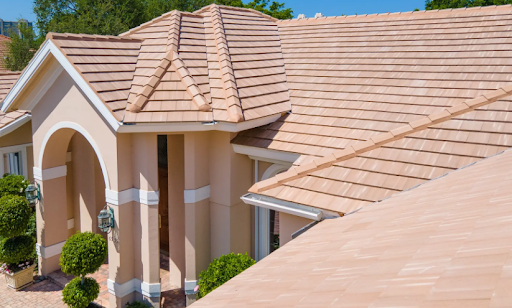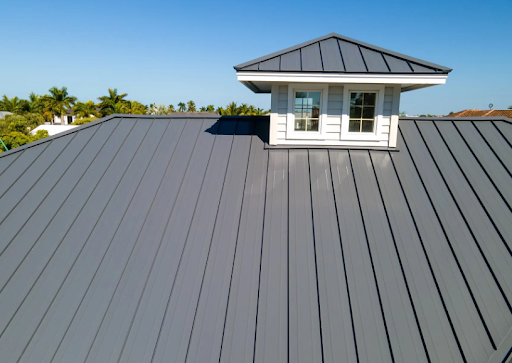Does Roofing Material Affect Your House Temperature?

Yes, your roofing material affects your home’s temperature. The type of material, color, and construction of your roof all play a role in how much heat gets into or stays out of your living space. If you live in a hot climate or want to make your home more energy-efficient, the type of material for your roof needs to be considered.
In this article, we’ll break down how different roofing materials impact indoor comfort, energy bills, and more.
Why Roofing Material Matters for Temperature
Your roof is one of the biggest surfaces in your home exposed to sunlight. On hot summer days, roof temperatures can climb well over 150°F. What happens next depends largely on the material:
- Some materials absorb and trap heat, making your attic and home warmer.
- Others reflect heat or release it quickly, helping keep things cooler inside.
A poorly chosen roof material can make your HVAC(Heating, Ventilation, and Air Conditioning) system work harder, which leads to increasing cooling costs. Thus, smart material choices can help reduce your utility bills.
Factors That Influence Temperature
Several things affect how much heat your roof holds or releases:
- Material type: Metal, tile, asphalt, and wood all behave differently.
- Color: Lighter colors reflect more sunlight while darker shades absorb more.
- Ventilation: Proper attic ventilation lets heat escape and keeps temperatures down.
- Insulation: The better your insulation, the less heat transfers into your home.
- Roof pitch: Flat roofs hold more heat, while sloped roofs lose heat faster.
Each of these factors contributes to how hot or cool your roof gets and how that impacts your indoor comfort.
How Common Roofing Materials Compare

Let’s take a closer look at how the most popular roof types perform in terms of temperature control:
1. Asphalt Shingles
- Common and affordable, but not the most energy-efficient.
- Dark shingles absorb heat quickly, which can raise attic temperatures.
- Lighter-colored shingles are better at deflecting heat.
- Not the best for hot climates unless paired with radiant barriers or cool-roof coatings.
2. Metal Roofs
- Highly reflective, especially when painted white.
- Releases heat quickly once the sun sets.
- Works well with cool-roof coatings for added efficiency.
- One of the best choices for hot climates.
3. Clay or Concrete Tile Roofs
- Heavy materials with high thermal mass.
- Absorb heat during the day but release it slowly overnight.
- Often used in hot climates because of this slow heat transfer.
- It can be coated for better reflectivity.
4. Slate Roofing
- Natural stone offers excellent durability and a high thermal mass.
- Absorbs heat but also provides good insulation.
- Great for both cold and warm climates, depending on the properties’ ventilation setup.
5. Wood Shingles and Shakes
- Offer some natural insulation but less reflective.
- It can retain heat and may not be ideal for very hot areas.
- Needs proper treatment and maintenance to perform well.
6. Green (Living) Roofs
- Covered in vegetation and soil.
- Provide excellent insulation and cooling.
- Help absorb rainwater and reduce heat islands.
- Ideal for eco-conscious homeowners, but expensive to install.
Consider a Cool Roof Upgrade
Cool roofs are designed to reflect more sunlight and absorb less heat. You can achieve a cool roof through:
- Specially coated asphalt shingles
- Reflective metal roofing
- Roof coatings for flat or low-slope roofs
Some states even offer tax credits or rebates for installing energy-efficient roofing.
How Roof Color Affects Heat Absorption
Roof color plays a big role in how much heat your home absorbs, especially in sunny climates.
Light-Colored Roofs:
Light-colored roofs reflect more sunlight, reducing heat absorption. Thus, keeping the attic and the living space at much lower temperatures. This leads to a lower energy demand on your air conditioner, which can help reduce energy bills during the summer. Ideal for hot climates like Florida or the Southwest.
Dark-Colored Roofs:
Dark-colored roofs absorb more of the sun’s rays, which can raise attic temperatures by 50–60°F. Hence, increasing the temperature of the living spaces because of the heat transfer. Energy costs can be more expensive as the home’s AC system works overtime.
A Note on New Technology:
Some modern shingles and tiles come with reflective coatings that reduce heat gain even in darker shades. If you like the look of a dark roof, consider energy-efficient roofing materials designed for solar reflectance.
The Role of Insulation and Ventilation
Even with the best roofing material, your home can still feel hot or cold if it’s missing two key things. They are insulation and ventilation.
Why Insulation Matters
Insulation acts as a thermal barrier. It slows the transfer of heat between your attic and living spaces. Without it, the heat that builds up under your roof can easily seep into your home. Forcing your air conditioner to work overtime.
- In summer, insulation helps keep hot air out.
- In winter, it helps trap warm air inside.
- It improves overall energy efficiency year-round.
- Helps prevent moisture buildup and potential mold growth.
Homes with poor or outdated attic insulation often struggle with uneven temperatures and high energy bills, no matter what roofing material is installed.
Why Ventilation Is Equally Important
Ventilation lets hot and stale air escape from your attic. Without it, your attic becomes a heat trap and that heat radiates down into your home.
- Reduces attic temperatures by allowing hot air to escape
- Helps remove moisture from humid air to reduce the risk of rot
- Keeps shingles from overheating and aging faster
- Extends the life of your roofing system
A well-designed roofing system includes both intake vents (usually along the soffits) and exhaust vents (at the ridge or roof peak). These work together to keep airflow moving and temperatures stable.
What Roof Material Is Right for Me?
Choosing the right roofing material depends on several things such as your home’s design, your budget, your local climate, and how much maintenance you’re willing to do. Each material affects indoor temperatures differently and offers unique advantages.
Here’s a breakdown to help you decide:
- Asphalt Shingles: Affordable, widely available, and easy to install. They reflect some heat but can retain warmth without proper ventilation. Best for moderate climates or homeowners on a budget.
- Metal Roofing: Highly reflective and energy-efficient. Metal roofs can reduce heat absorption, especially when coated with reflective paint. Great for hot climates and those looking to cut cooling costs.
- Tile Roofing (Clay or Concrete): Dense and heavy, tile roofs naturally resist heat and allow air to circulate underneath. Excellent for hot, sunny regions like Florida. However, they can be costly and require a strong roof structure.
- Slate Roofing: Long-lasting and durable, but expensive. Slate doesn’t absorb heat as easily and can maintain a stable indoor temperature. Often used for high-end homes.
- Cool Roofs (White Membrane or Coated Systems): Designed specifically for energy savings. These materials reflect more sunlight and stay cooler than traditional options, making them ideal for flat or low-slope roofs.
Still unsure? Talk to a roofing expert about your home’s needs. They can factor in your attic insulation, ventilation setup, and sun exposure to help you choose the best option.
Why Homeowners Trust King Roofing
Choosing the right roofing material is only half the battle. Having it installed by experienced professionals makes all the difference. That’s where King Roofing comes in.
We’ve served southwest Florida homeowners for over 45 years. We understand how roofing materials, ventilation, color, and insulation all work together to control heat and improve energy efficiency.
Here’s what you can expect from King Roofing:
- Free roof inspection and expert advice: We’ll assess your current roof and explain how it’s affecting your home’s temperature.
- Options tailored to Florida’s climate: From reflective shingles to metal roofing, we’ll recommend what performs best in hot, humid conditions.
- Licensed and insured installation: Our crew is trained to meet Florida building codes and ensure your roof lasts for decades.
- Energy-efficient upgrades: We offer materials and designs that can help reduce your cooling costs without sacrificing style.
- Honest and Straight Forward service: We won’t exaggerate. If a repair is all you need, we’ll tell you.
Whether you’re ready for a full roof replacement or just looking to explore your options, King Roofing is here to help.
Ready to Improve Your Roof’s Efficiency?
Your roofing material choice plays a big role in how comfortable your home feels, especially during the hot summer. The right material can reduce heat gain, cut cooling costs, and make your home more efficient. If your current roof is dark, poorly ventilated, or nearing the end of its life, consider upgrading the roof material to something more energy-efficient.
If you’re thinking about replacing your roof or upgrading to a more energy-efficient system, we can help. Contact King Roofing to help you choose which roofing materials fit your home, the climate, and your budget. Whether you’re planning new construction or replacing an older roof, we’ll guide you through the best options to lower energy costs and improve year-round comfort.












